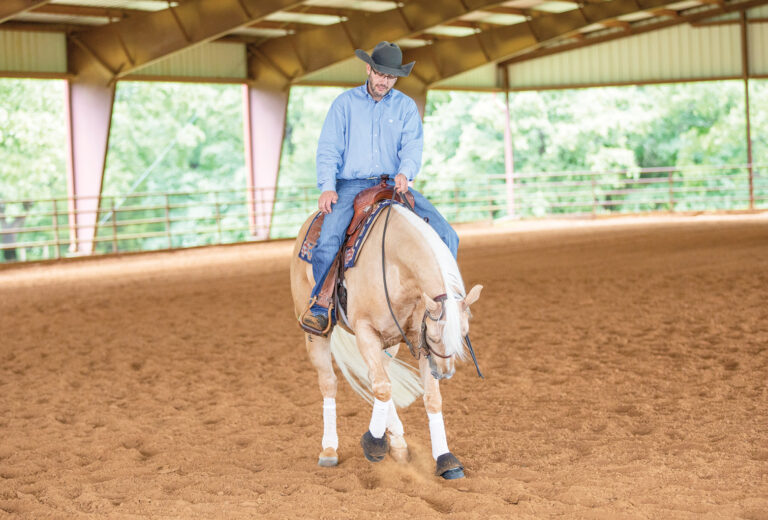No matter what discipline you’re riding, you’re most likely going to want your horse to be supple and limber. Suppleness is when your horse is able to freely bend and work his muscles through his neck to his back without tension. If your horse feels stiff, tense, or struggles to bend the way you ask him, he probably needs to work towards suppleness.
Multiple world champion Western dressage trainer Tim Christensen has his non-pro riders practice a stretching exercise to help their horses become more fluid and supple. While suppleness is an important factor in Western and traditional dressage, it’s beneficial in any kind of riding from reining to trail riding. If you push your horse too hard and their muscles aren’t limber or properly stretched, they won’t be able to perform as well as you are asking and it’s possible they will end up with an injury. This is the same as you going for a run without properly stretching your muscles first. Odds are you will have a hard time running and you might pull a muscle. So on your next ride, try incorporating this quick exercise into your routine and watch as your horse loosens up and becomes more supple in your hand.
Start in a Confined Space
Tim usually has his students practice this exercise in his smaller arena between the rail and his dressage arena. While this helps keep the riders on a good track, it’s not a necessary part of the drill. You can practice this virtually anywhere, but it’s best to start on the rail of your arena or in a round pen so you don’t have to worry too much about steering or things getting in your way.

Photo by Jillian Sinclair
Try It At the Walk
If this is the first time you’re introducing suppleness to your horse, start at the walk until he understands what you’re asking of him. Walk down your rail in a straight line and gently ask your horse to move his head to the inside of your arena. So, if you’re going to the left you will ask your horse to pull his head to the right. You don’t want to pull his head until it’s completely facing the inside, but just enough that you can see the inside corner of his eye.

Photo by Jillian Sinclair
The most important part of this exercise is to keep his body walking straight in front of you down the rail while bringing his head to the inside. If his shoulders follow his head and turn to the inside, you aren’t stretching any part of his body, you’re just steering him to the inside. Keep him balanced between your legs and use your outside hand to keep his outside shoulder from turning towards the inside. You should be able to feel some tension in the reins as his neck stretches towards his head while keeping his shoulders straight.

Photo by Jillian Sinclair
[More on Suppleness: 4 Lateral Movements to Improve Collection]
Give Some Release
Keep your horse walking with his neck stretched towards the inside for the length of one side of your arena and when you get to the end of that rail, release and let his head come back in front of his body. When you get to the other side, ask him to bend again until you get to the end of that rail. It’s important to make him stay bent long enough to stretch the muscles, but you don’t want to overwork him by not giving any release.
Once you feel satisfied with the direction you’re working, reverse and repeat the exercise going the opposite direction. It’s normal to find that one direction is easier for your horse than the other. The goal is to get him limber and balanced enough that both directions are easy for him.
Take It Up a Notch
Once your horse is comfortable going both directions with his head slightly bent to the inside at the walk, try asking him to bend while at the trot. You want to have the same outcome as before — his head slightly bent to the inside of your arena, his shoulders facing straight and not following his head, and his body moving forward straight down the rail. Your horse should move fluidly at the trot and be able to easily move forward while stretching his neck. If not, go back to practicing at the walk until the trot comes easier. You can post or sit the trot during this exercise, whatever is most comfortable to you.

Photo by Jillian Sinclair
Once you’re freely trotting and able to bend your horse’s head slightly to the inside of your arena and hold it there while moving forward, try bending his head even more towards the center and stretch those muscles even more. If you struggle increasing the bend at the trot, try introducing it at the walk first.
By the end of this exercise, your horse should feel loose and limber through his neck because his muscles have been properly stretched so he is supple and ready for his next challenge.
[More on Bending Exercises: Keep the Bend with Brad Barkemeyer]






